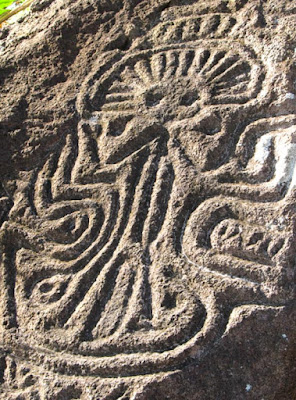“Ometepe is an island formed by two
volcanoes rising out of Lake Nicaragua in the Republic of Nicaragua.
Its name derives from the Nahuatl words ome (two) and tepetl (mountain),
meaning "two mountains". It is the largest island in Lake
Nicaragua. The two volcanoes (known as Volcan Concepcion and Volcan Maderas)
are joined by a low isthmus to form one island in the shape of an
hourglass, dumbell or peanut. Ometepe has an area of 276 square kilometres
(107 sq mi). It is 31 kilometres (19 mi) long and 5 to 10 kilometres
(3.1 to 6.2 mi) wide.” (Wikipedia)
“The island first became inhabited during the Dinarte phase (c. 2000 BC – 500 BC), although evidence is questionable. The first known inhabitants were speakers of Macro-Chibchan languages. Traces of this past can still be found in petroglyphs and stone idols on the northern slopes of the Maderas volcano. The oldest date from 300 BC. Several centuries later, Chorotega natives created statues on Ometepe carved from basalt rock.” (Wikipedia) According to the local museum (Museo de Ometepe) there are over 1,700 recorded petroglyphs on this island.) But, Julian Smith of Archaeology Magazine has set the number at over 2,000 petroglyphs. It would appear that the original inhabitants produced petroglyphs primarily while the newcomers added sculpture to the list.
“Rock art is abundant throughout the
region, and includes petroglyphs depicting geometric motifs, abstract shapes,
and images of human figures and animals such as birds, monkeys, and caimans, as
well as jaguar paw prints. A 17-year survey of rock art on Ometepe Island led
by Suzanne Baker of Archaeological/Historical Consultants identified at least
2,000 petroglyphs at 116 sites.” (Smith 2024:60)
“’Zoomorphic’
figures, on the other hand, are relatively infrequent, and occur in both representational
and stylized forms. Of the former, the monkey is said to be the most common
motif. Other designs include quadrupeds (infrequent, but tend to be found in
complex panels), amphibians such as frogs and toads (infrequent), and birds
(rare). Figures of reptiles have also been found. Images of lizards and
crocodiles have occurred occasionally, whilst those of turtles are infrequent.
Additionally, some figures of snakes are present in the petroglyphs. It has
also been suggested that some curvilinear designs may be stylized forms of
snakes. Other stylized ‘Zoomorphic’ figures include possible bird heads and a
crocodilian figure.
There
are also a number of head-like designs that can neither be called
anthropomorphic nor zoomorphic. These have been placed by the researchers under
the category of ‘Mask-like Forms”’. Finally, there is a category called
‘Miscellaneous Motifs’. These include images of flowers or butterflies,
sun-like symbols, calendars, and cruciform figures.” (Mingren 2015)
These last two quotations illustrate
the difficulty of using trait lists in describing rock art, Julian Smith (2024)
and Wu Mingren (2015) appear to contradict each other in their classifications
of the petroglyphs with Smith implying that various categories are quite common
while Mingren stating that those categories are rare. From the pictures and
other reports, however, I receive a very strong impression that there is a lot
of rock art on Ometepe Island and that it is almost magically impressive.
NOTE: Some images in this posting were retrieved from the internet with a search for public domain photographs. If any of these images are not intended to be public domain, I apologize, and will happily provide the picture credits if the owner will contact me with them. For further information on these reports you should read the original reports at the sites listed below.
REFERENCES:
Mingren, Wu, 2015, The Mysterious Petroglyphs of Ometepe, Nicaragua, 3 October 2015, https://www.ancient-origins.net. Accessed online on 11 December 2022.
Museo de Ometepe, 2023, Museo de Ometepe, 25 August 2023, https://ometepeislandinfo.com/Museo-Ometepe. Accessed online 25 August 2023.
Smith, Julian, 2024, Who Were the People of Greater Nicoya?, Archaeology Magazine, March/April 2024, Vol. 77, No. 2.
Wikipedia, Ometepe, https://en.wikipedia.org/wiki/Ometepe.
Accessed online on 12 December 2022.













Peter, this is very interesting. Ometepe Island is or was a sister island to Bainbridge Island, WA while I was living there 1987-1998. I have a huge notebook full of black and white xerox terrible pictures of hundreds of glyphs. I'm so pleased to see some of them in color! and to see they have gotten funding to protect the sites.
ReplyDelete